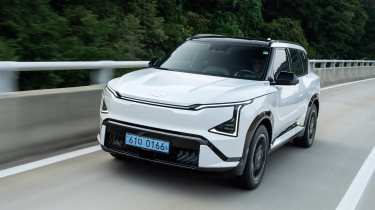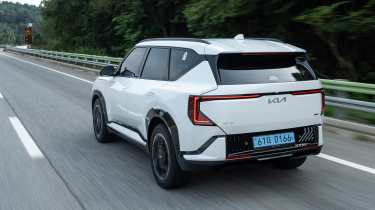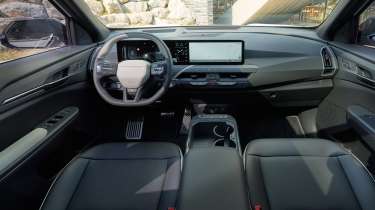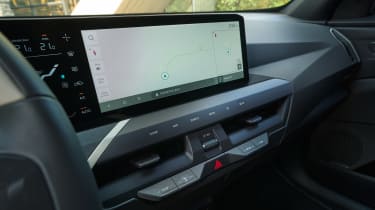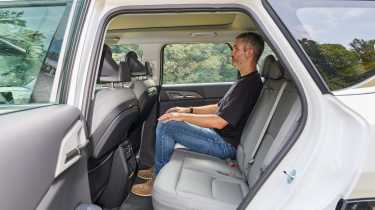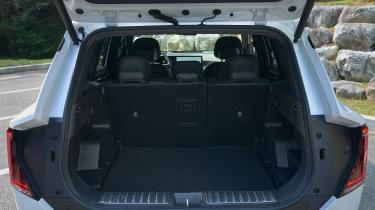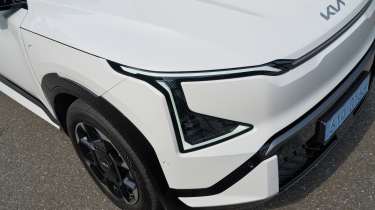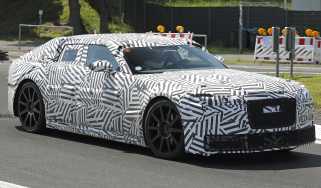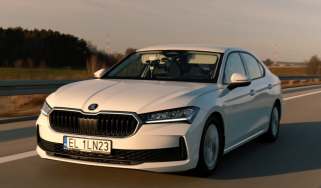Kia EV5 review
The Kia EV5 is an intriguing alternative to class stalwarts such as the Skoda Enyaq and Tesla Model Y, but it doesn’t do quite enough to raise the bar

Our opinion on the Kia EV5
There is little wrong with the new Kia EV5 in isolation, yet it struggles to stand out in an increasingly crowded class. Customers coming from the hybrid-powered Sportage will revel in its familiarity, yet we can’t help but feel that an EV leader like Kia could have done more to offer something genuinely unique. The true test will come when we get the newcomer alongside its key rivals on UK roads, soon.
About the Kia EV5
The mid-size electric SUV segment has morphed into one of the most overpopulated areas of the new-car market. Almost every mainstream manufacturer has put a flag in the ground, with many now seeing strong conversion from their equivalent petrol, diesel or hybrid alternatives.
But, Kia – a brand widely considered a leader in electrification – has taken longer than most to stake its claim, and is only now bringing its hotly anticipated EV5 to market. It’s a rival to cars including the Skoda Enyaq, Volkswagen ID.4 and Tesla Model Y, but is it a case of too little, too late?
To get a taste of what customers can expect when deliveries commence later this year, we travelled to Korea to drive a top-spec, front-wheel-drive model – largely comparable to the plush GT-Line S that will be offered from launch. In 2026, this single-motor car will be joined by an all-wheel-drive model, plus a 302bhp flagship GT.
Kia EV5 prices and latest deals
The Kia EV5 starts from £39,295, which means base models just escape the ‘premium’ or ‘luxury’ road tax supplement for cars costing £40,000 or more. However, those who want a bit more kit – or the option of an energy-saving heat pump – will need to step up, and pay an extra £425 of VED road tax every year for the first six years.
Used - available now

2021 BMW
X3
28,761 milesAutomaticPetrol2.0L
Cash £28,300
2024 Audi
A3 Saloon
35,055 milesManualPetrol1.5L
Cash £17,897
2020 Audi
Q5
31,000 milesAutomaticPetrol2.0L
Cash £32,415
2022 Mazda
CX-5
18,279 milesAutomaticPetrol2.0L
Cash £25,995While prices have been announced, first cars aren’t due in the UK until the very end of 2025, with customer deliveries set to start early in the new year. As such, there are no deals available on the Auto Express Buy A Car service, and lease offers are yet to be published.
Performance & driving experience
Pros |
|
Cons |
|
On the road, Kia’s entry into the mid-size electric SUV class is safe, predictable and almost entirely unremarkable. That might sound like we’re damning the car with faint praise, but such traits have never held the similarly sized Sportage back from topping the segment sales chart, and we doubt they’ll do the EV5 any harm either.
The steering is light, but precise, feeding more than enough shove to the front wheels, which never feel overwhelmed by your inputs. You can restrict power and boost range by selecting one of the lesser drive modes, and doing so doesn’t make the car feel overly lethargic.
Flick it through to Sport mode and this entry point to EV5 ownership will do 0-62mph in 8.4 seconds – a task it performs with a subtle sci-fi soundtrack. It won’t transform this family SUV into a Hyundai Ioniq 5 N-rivalling hot hatch, but it adds a layer of engagement, and it’s not so annoying that you’ll be delving into the menus desperately trying to turn it off.
The car resists body roll just as well as you’d expect, and we found it to be quiet and comfortable on almost every Korean surface we encountered. Again, that feeling of familiarity is what shines through – mostly for the better. There are no nasty surprises, but it’s not oozing with character either.
As on the PV5 we drove recently, an honorable mention goes to Kia’s expertly tuned, best-in-the-business regenerative braking system. It varies from a full coast mode to a strong one-pedal drive, plus an intuitively calibrated adaptive setting, and you can flick through the wide-ranging spectrum on the fly, via paddles on the steering wheel. We wonder why all car companies haven’t carbon-copied this feature; much like engine braking, it allows you to slow the car more efficiently – all the while feeding precious power back into the battery.
Electric motors, 0-60mph acceleration and top speed
The only model offered at launch will be the Long Range car with a single electric motor mounted to the front axle. This is the car we drove on the international launch in Korea; 0-62mph takes 8.4 seconds, and top speed stands at 102mph.
In 2026, a dual-motor all-wheel drive car with 261bhp will join the range, cutting the 0-62mph time to 7.3 seconds. The flagship GT should arrive around the same time, boasting 302bhp and a 0-62mph time of six seconds flat. That’s quick, but not as potent as the Skoda Enyaq vRS, which completes the same sprint in just 5.4 seconds.
| Model | Power | 0-62mph | Top speed |
| Kia EV5 FWD | 214bhp | 8.4s | 102mph |
| Kia EV5 AWD (due 2026) | 261bhp | 7.3s | TBC |
| Kia EV5 GT (due 2026) | 302bhp | 6.0s | TBC |
Town driving, visibility and parking
The EV5’s light steering and generous glasshouse make it one of the easier mid-size SUVs to pilot around town. The myriad sensors and cameras should also help keep you out of trouble.
Country road driving and handling
Calling the EV5 ‘familiar’ is probably the biggest compliment we can pay it. Those coming from a petrol or hybrid-powered Kia Sportage should find the switch to EV easy, and that goes for the driving experience, too.
It’s fun as such, but it handles neatly and predictably. There’s enough grip, and the compliant suspension means it won’t unwittingly throw you off-course mid-corner. The steering is light, but precise, striking a decent balance between making the car easy to manoeuvre and reasonably responsive on a country road.
Motorway driving and long-distance comfort
Along with its agreeable town-driving manners, the EV5 also excels on the motorway. It’s comfortable and particularly refined, while the strong efficiency means you shouldn’t find yourself stopping to charge too often, either.
“The Kia EV5 is unexciting and totally predictable to drive, which in our eyes is both its most appealing attribute, as well as what prevents it from standing out in the busy mid-size SUV segment." - Richard Ingram, deputy editor.
Range, charging & running costs
Pros |
|
Cons |
|
In terms of specs, the EV5 matches many of its rivals without really moving the game on in any way. It’s based on Kia’s E-GMP platform, but shares more with the smaller EV3 than it does the hi-tech EV6 or EV9. That means it uses the more affordable 400-volt electrical architecture, missing out on the 200kW-plus peak charging speeds offered on Kia’s top-end EVs.
Electric range, battery life and charge time
The EV5 will still hit 150kW when connected to a compatible charger, and go from 10 to 80 per cent in around 30 minutes – similar to its main rivals but nothing more. There’s just one 81.4kWh battery available, promising up to 329 miles of range – although the bigger wheels of our GT-Line S test car will probably peg that back a bit.
Yet on our test route, which blended a good mix of very heavy stop-start traffic, high-speed motorway runs and rural roads with significant elevation, we managed about 3.8mi/kWh – equivalent to some 300 miles of range. Granted, the warm-ish (22 to 23 degrees) weather will have helped, but it means similar efficiency won’t be out of the question in the summer months back in the UK. It’s worth noting that a heat pump is not standard fit, and can only be specified as an option on the GT-Line S for an extra £900. We reckon that’s a bit stingy.
Insurance groups
Insurance groups for the Kia EV5 haven’t been revealed yet; we expect them closer to the car’s UK market launch in late 2025/early 2026.
Tax
Only the very cheapest EV5 ‘Air’ comes in at under £40,000, but even this car is pretty well equipped. If you can avoid the tempting GT-Line or GT-Line S models, you’ll save yourself £425 per year in annual VED (road tax).
Depreciation
We don’t yet have any official figures for how much value the Kia EV5 will retain during its first three years or 36,000 miles. However, as a general rule, Kias don’t quite keep pace with their European rivals – expect the EV5 to lose around 50 per cent of its initial purchase price during this time.
| Model | Battery size | Range | Insurance group |
| Kia EV5 | 81.4kWh | 329 miles | TBC |
| Kia EV5 AWD (due 2026) | 81.4kWh | TBC | TBC |
| Kia EV5 GT (due 2026) | 81.4kWh | TBC | TBC |
Interior, design & technology
Pros |
|
Cons |
|
The EV5 comes pretty well equipped as standard. Every version – including the sub-£40k Air – gets at least 18-inch wheels, automatic LED lights and privacy glass, while inside there are heated seats, automatic air-conditioning and a triple-screen infotainment system comprising two 12.3-inch read-outs for the instrument cluster and central display, plus another five-inch panel for the climate controls, nestled neatly in between. Wireless Apple CarPlay and Android Auto both feature, while we found the set of chunky, physical switches on the console allowed for easy adjustment of the temperature and fan speed.
Step up to GT-Line (from £42,595) and you get a different, 19-inch wheel design and specific exterior styling elements, as well as a powered tailgate, artificial leather upholstery, heated seats in the back and vehicle to load (V2L) capability with a three-pin plug to power external devices. If you can stomach the additional road tax – remember, even EVs have to pay the ‘luxury’ surcharge now – we think this version offers the best balance between initial cost and standard kit.
A GT-Line S car like ours is pricey, however. Starting at £47,095, it brings premium features such as an opening panoramic roof, ventilated front relaxation seats (that can recline and massage while charging), plus a Harman Kardon stereo, a head-up display and 360-degree cameras. It also comes with digital key functionality, plus a fingerprint reader on the centre stack. But we think most buyers will be best served by one of the two cheaper EV5s.
Interior and dashboard design
The interior layout is, once again, pretty familiar. That’s no bad thing; the infotainment system spans three screens – including a small display for the climate controls. The temperature is easy to adjust, thanks to separate physical switches on the centre stack.
Materials and build quality
The EV5 feels built to last, even if it doesn’t set any new standards for perceived quality in the mid-size SUV class. The seats are comfortable and the surfaces you interact with feel plush yet reasonably hard wearing. There’s no compromise for those in the rear, either, where the fit and finish is on par with the rest of the cabin.
Infotainment, sat-nav and stereo
As mentioned, the infotainment system spans three distinct areas pulled together in one panel stretching behind the steering wheel right out into the centre of the dash.
The main screen is easy to navigate and has all the functionality you’d expect, including wireless Apple CarPlay and Android Auto enabling you to project the contents of your phone onto the EV5’s display. The fully-digital instrument cluster is another plus point, with clear and easy-to-read fonts, and menus that you can flick through on the fly.
The only issue is the small display for the climate controls, which is obscured by the steering wheel. Still, once you’ve found your desired temperature, you’ll likely not have to play with it all that much anyway.
“While we’d want to spend an extended amount of time poking around, prodding and living with the EV5, it felt well engineered and built to last during our Korean test drive." - Richard Ingram, deputy editor.
Boot space & practicality
Pros |
|
Cons |
|
While the EV5 might not scream ‘value’, it is at least pleasingly practical for a car in this class. There’s lots of storage up front, the back seats are impressively spacious both in terms of headroom and legroom, and there’s absolutely no hump in the floor, so you can even sit relatively comfortably in the middle seat. There are ISOFIX points on the outer rear seats, but rivals also offer mountings on the front-passenger chair; the Kia doesn’t.
A clever folding mechanism, whereby the seat bases and backs move in tandem, means that the rear bench goes completely flat – revealing a big, square and uninterrupted load bay. This allows the 566-litre boot to extend up to 1,650 litres, very nearly matching the spacious Skoda Enyaq for load-carrying capacity. But while the Skoda doesn’t offer any space under the nose, the EV5 boasts a 44-litre frunk – perfect for the charging cables, or in our case, a laptop bag.
Dimensions and size
| Dimensions comparison | |||
| Model | Kia EV5 | Skoda Enyaq | Tesla Model Y |
| Length | 4,610mm | 4,658mm | 4,790mm |
| Width | 1,875mm | 2,147mm | 1,982mm |
| Height | 1,675mm | 1,624mm | 1,624mm |
| Wheelbase | 2,750mm | 2,770mm | 2,890mm |
| Boot space | 566 - 1,650 litres | 585 - 1,710 litres | 890 - 2,130 litres (measured to roof) |
The Kia EV5 is ever so slightly shorter than a Skoda Enyaq, but longer than a Volkswagen ID.4. A Tesla Model Y dwarfs it in every direction except for height, while a Toyota bZ4X is longer, but narrower and lower than the Kia.
Seats and passenger space
The Kia’s bespoke electric platform means there’s loads of space inside the EV5, whether you’re sitting up front or in the rear. There’s a huge area between the front seats to stash stuff, while in the back there’s a completely flat floor, which means even those in the middle will have plenty of room for their feet.
Boot space
The Kia’s 566-litre boot only really falls short of the Skoda Enyaq on paper – the reality is it’s a great shape and size, while the upright rear end means even boxier items should slide in without issue. The rear seats fold cleverly to go completely flat – revealing a generous 1,650 litres of load-carrying capacity.
Towing
The EV5, even in single-motor form, can tow up to 1,200kg. We expect the AWD and AWD GT models due in 2026 will be able to haul even more.
“The EV5’s boxy profile and bespoke electric platform reveal a spacious interior and big boot. We found the folding rear seats particularly innovative, as they concertina to create a completely flat load bay.” - Richard Ingram.
Reliability & safety
Pros |
|
Cons |
|
The Kia EV5 is so new, we’ve no data for reliability, and the car is yet to be tested by independent crash-test body Euro NCAP. Kia generally has a strong reputation with owners, though it did fall to 18th (out of 31) manufacturers in the 2025 Driver Power owner satisfaction survey. The brand will be hoping for an uplift next year.
It’s likely that Euro NCAP will look to test the Kia EV5 in the adult occupancy, child occupancy, vulnerable road user and safety assist categories as soon as possible – maybe even before year end.
Like every Kia, the EV5 comes with a seven-year, 100,000-mile warranty – more than double what many of its European rivals can offer. If you plan to keep your car for longer than most, this kind of cover could pay for itself several times over.
Buying and owning
- Best buy: Kia EV5 Air
Given the EV5 Air is the only model to come in under £40,000 – and therefore skirt around the ‘premium’ car road-tax surcharge – it’s the model we’d recommend. These cars get 18-inch wheels, LED lights, heated seats and that three-screen infotainment system. Wireless Apple CarPlay and Android Auto are also included.
Kia EV5 alternatives
The Kia EV5 enters one of the most hotly-contested areas of the market, with rivals spanning everything from the Skoda Enyaq to the Tesla Model Y. Other options include the Audi Q4 e-tron, Citroen e-C5 Aircross, Ford Explorer and Nissan Ariya, as well as the Renault Scenic, Toyota bZ4X and Vauxhall Grandland.
Deals on the Kia EV5 and alternatives
Frequently Asked Questions
The EV5 gets the same seven-year, 100,000-mile warranty as all Kia cars.


